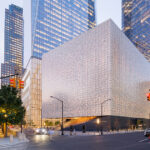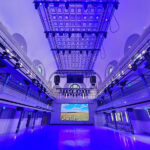In October 2013, pop music icon Katy Perry held an album release party for her latest studio offering, Prism, at iHeartRadio Theater in Burbank, CA. After making a special appearance at the media and events venue, Perry was interviewed by The X Factor host Mario Lopez for an event that was broadcast by 175 Clear Channel stations across the U.S.
A month later British boy band One Direction swept through L.A. and held a similar event for their album, Midnight Memories, as part of an evening hosted by on-air TV personality and producer Ryan Seacrest.
 Some telecommunication outlets might content themselves with carving out a corner market in the entertainment industry, but Clear Channel Media and Entertainment, owner of iHeartRadio Theater, proves why it’s a contender for the throne of king of all media by offering an intimate concert setting for major-league artists while broadcasting their music to millions.
Some telecommunication outlets might content themselves with carving out a corner market in the entertainment industry, but Clear Channel Media and Entertainment, owner of iHeartRadio Theater, proves why it’s a contender for the throne of king of all media by offering an intimate concert setting for major-league artists while broadcasting their music to millions.
“Clear Channel is a global leader and innovator in media and entertainment, and we saw that the Burbank/Hollywood/Los Angeles location would be a great place to create this new space for events, content captures and our various on-location productions, because of the availability of A-list and emerging talent in the area,” says Steve Davis, senior vice president, facilities and capital management at Clear Channel Media and Entertainment.
 Inspired by the success of the 250-person-capacity iHeartRadio Theater in New York City, Clear Channel believes it can satisfy end users and turn a profit on the West Coast. An ambitious project to be sure, iHeartRadio Theater Burbank required entertainment systems designer Tyler Littman, of Sholight Entertainment Design, to tap every ounce of his knowledge of lighting and rigging.
Inspired by the success of the 250-person-capacity iHeartRadio Theater in New York City, Clear Channel believes it can satisfy end users and turn a profit on the West Coast. An ambitious project to be sure, iHeartRadio Theater Burbank required entertainment systems designer Tyler Littman, of Sholight Entertainment Design, to tap every ounce of his knowledge of lighting and rigging.
Initially brought onto the project as lighting design consultants in September 2012, Littman and associate designer Stephen Wyker were soon asked to take on a bigger role as the project grew dynamically over the first few months of planning. Sholight was also charged with making the space functional as well as manageable for an optimal production staff.
 “We didn’t want to limit ourselves — from our fixture selections to our layout of the rigging system to the control systems,” says Littman. “We wanted a huge amount of flexibility while also having a lot of possibilities.”
“We didn’t want to limit ourselves — from our fixture selections to our layout of the rigging system to the control systems,” says Littman. “We wanted a huge amount of flexibility while also having a lot of possibilities.”
From Plan to Completion
The theater, once the home of NBC’s The
Tonight Show with Jay Leno, holds 450 people and houses radio broadcast and video broadcast and edit facilities, a 20,000-square-foot performance space and second-floor VIP and hospitality areas, among other features. iHeartRadio is also infused with cinematic possibilities.
 “Clear Channel really wanted iHeart to satisfy a few different needs,” says Littman. “This was definitely one of the most complex projects I’ve ever worked on.”
“Clear Channel really wanted iHeart to satisfy a few different needs,” says Littman. “This was definitely one of the most complex projects I’ve ever worked on.”
The planning and design process for the space took a year, during which time Clear Channel met with “vendors, designers, architects and equipment and production experts,” says Davis. “Our national programming platforms team worked closely with cinema consultants to ensure that we had a world-class space that was unmatched.”
Nemetschek Group’s architectural and entertainment CAD software Vectorworks was a tremendous help with this project, Littman says. The software program “saved us a lot of drama,” says Littman, who used Vectorworks for everything from “figuring out the rigging layout to figuring out all my photometric calculations that I did for the architectural lighting. All of the electrical drawings for both the architectural and entertainment system were done in Vectorworks. Then all that information was directly linked to a database application, which we build in-house, so that we’re able to track individual fixtures and physical dimmers. It’s a relational database, so we’re able to link all the information together so we can very easily say, ‘This light in this dressing room has been associated to this dimmer module on this rack, and it’s been assigned this type of dimmer module and needs this type of wire.’ All that information can then be easily updated and quickly passed to contractors.”
 When finished, the venue packed plenty of visual delights and media operations. For instance, two 5mm Barco C5 LED panels, each measuring 15.7 by 9.2 feet, are inset on walls left and right of side of the stage. Another custom dimension C5 screen is fixed to the main lobby walls. A corridor, adjacent to the lobby, houses the production areas, including the radio broadcast booth, video control and editing area and a full audio suite. Guests can peer down at the 75-by-60-foot main theater floor from rows of fixed seating located in the balcony or the mezzanine’s VIP and hospitality suites.
When finished, the venue packed plenty of visual delights and media operations. For instance, two 5mm Barco C5 LED panels, each measuring 15.7 by 9.2 feet, are inset on walls left and right of side of the stage. Another custom dimension C5 screen is fixed to the main lobby walls. A corridor, adjacent to the lobby, houses the production areas, including the radio broadcast booth, video control and editing area and a full audio suite. Guests can peer down at the 75-by-60-foot main theater floor from rows of fixed seating located in the balcony or the mezzanine’s VIP and hospitality suites.
“The only thing that was really left over [from the old Leno studio] was the dividing wall between the theater and the production areas, where all the control rooms are,” says Littman. “They also left the decking from the original theatrical seating in the balcony as well as the old fly-rail, now nonfunctioning, to act as a backdrop for the dressing room corridor. Everything else around it was ripped out. The VIP and hospitality areas were complete add-ons.”
 Lighting Rigs
Lighting Rigs
The venue’s multi-million-dollar lighting rig is divided into three different systems: theatrical, architectural, and studio. A series of fixture tests and camera shootouts were performed for Davey Sherwinter, video director for iHeartRadio, who made the call on what fixtures were needed and which were superfluous.
“Davey was something of a creative director for the space and is great at using technology in ways that make sense,” says Littman. “It’s what most designers in my shoes would want out of a client, and it’s not something you get everyday.”
 iHeartRadio is well stocked with a diverse theatrical lighting package. Automated lighting fixtures, installed by PRG, include various Clay Paky fixtures — Alpha Spot HPE 1500s, Alpha 1500 Washes, Sharpys, Sharpy Washes and A.Leda Washes — and 10 Martin MAC Viper Profiles, chosen for strong beams and graphic gobo capabilities. (The Vipers also provide clean backlight, says Littman.)
iHeartRadio is well stocked with a diverse theatrical lighting package. Automated lighting fixtures, installed by PRG, include various Clay Paky fixtures — Alpha Spot HPE 1500s, Alpha 1500 Washes, Sharpys, Sharpy Washes and A.Leda Washes — and 10 Martin MAC Viper Profiles, chosen for strong beams and graphic gobo capabilities. (The Vipers also provide clean backlight, says Littman.)
Also in the rig: PRG Best Boy 4000 spots, the “the Swiss Army Knife of lights, and my go-to keylight,” says Littman. He noted that while they may not be in everyone’s budget, “the shutter system is beyond anything on the market. Unlike most movers, this fixture has servomotors, not stepper motors. Everything is very fast and has almost 100 percent repeatability. If you’re changing the shutters from a podium look to a nice, clean, shuttered front wash, every single time the light moves from one position to the other it’s going to hit those marks. For television, I don’t think there is anything better.”
Theatrical lighting is controlled via MA Lighting’s full-sized grandMA2 and a Fader Wing with an OnPC Command Wing running as backup. (The lighting control booth, offering the operator sightlines of 120°, is located in the mezzanine.) “We decided to be as forward-thinking as humanly possible and have the entire system controlled via streaming ACN,” says Littman. “Out of the back of the lighting console, there are no physical 5-pin DMX connections. Everything comes out over Ethernet. All of the line sets, all of the wall plates for power around the room — everything has either one or two network connections. We have ETC Net3 gateway nodes set up as well, which is where all the DMX output happens. We strategically placed power and data connections in hallways, in VIP and hospitality areas and on the theater floor.”
Studio lighting features a variety of fixtures, such as Mole-Richardson Mole Solarspots, Mickey-Mole open face 1Ks, K 5600 Lighting’s Joker-Bug 800s, Kino Flo Flathead 80s, 4ft 4Banks, Celeb 200 DMX LED center mount kits, and Select 4Bank Ballasts — all in service to television lighting.
“Because it’s a TV studio, [Clear Channel] wanted to be able to shoot commercials for iHeart and Clear Channel.”
Architectural lighting fixtures inside the main studio space include GDS ArcSystem Pro 4 Cell and 8 Cell fixtures, 62 Color Kinetics ColorGraze Powercore 3ft fixtures and eight Color Kinetics eW Graze Powercore 4ft units to light the old fly-rail system.
“I went with a 4100° K, so it’s a nice balance between too warm — that tungsten look — and something too cold,” says Littman. “Because Davey wanted to use some conventional fixtures with moving lights, I wanted to pick an architectural light that was right in the middle.”
Touch of a Button
An ETC Unison Paradigm Central Control Server, along Unison Paradigm 18” Touchscreens (one in the lighting booth, one for video control), an ETC Unison Paradigm 7” Touchscreen (in the lobby), Unison Heritage Fader Interface Stations, Unison Heritage Button and Fader stations for on/off and dimming control, and GDS ARC-TX1 wireless transmitters, which receive DMX signals and convert them to mesh network protocol, allow for localized and global control of architectural lighting.
“In the darkened environment of stage production, touchscreens can make all the difference,” says Clear Channel’s Steve Davis. “Instead of a light shining on a control surface, the screen is both the control surface and the light. We used this mostly for lighting control.”
“Let’s say, the venue manager needs to show off studios to potential clients, who might want to rent the space for an event,” says Littman. “The manager would be able to walk up to a touch screen on the wall and configure the room into a ‘special event’ look. All the lighting and video content, via the LED walls, all come up at the touch of a button.”
Phase Two
Phase Two of the installation, involving a new cinema system, promises to be just as exciting and user-friendly; a 44-foot long Stewart motorized roll screen will provide the canvas for Christie 4K digital projectors. (One of the possible uses for iHeartRadio Theater might be to host Hollywood red carpet film premieres.) “Hit a button on the wall, and the screen drops down,” says Littman. “Everything is almost completely driven over fiber. There’s a rack in our main rack room where projectionists can drop a hard drive into a playback server and then go into the lighting booth and, via remote, trigger all the playback.”
It seems Sholight’s mission, to create a streamlined environment that’s all encompassing, yet operational, continues. “There’s a lot of venues that have bits of pieces of these things,” says Littman, “but not one — at least not any I’m aware of — has brought all of these elements together in this way before. It’s a unique space.”
Gear
1 grandMA2 full-size w/wing & NPU
1 OnPC Command Wing
10 PRG Best Boy 4000s
10 Martin MAC Viper Profiles
12 Clay Paky Alpha Spot HPE 1500
22 Clay Paky Sharpys (black and chrome)
8 Clay Paky Sharpy Wash 330s
8 Clay Paky A.leda B-Eye K10s
62 Color Kinetics ColorGraze Powercore 3ft
8 Color Kinetics eW Graze Powercore 4ft
24 ETC Desire D40 Vivid LED fixtures
20 Philips/Showline SL BARs (640 & 660)
33 GDS ArcSystem Pro Fixtures (29 8-Cell, 4 4-Cell)
8 PRG/Cineo TruColor HS units
8 Martin Atomic 3000 strobes
2 JEM Studio Lighting JEM Balls (30”)
68 ETC Source Four Ellipsoidals
44 ETC Source Four PAR EAs
16 James Thomas Spot Banks 2, 4, 8 Lite)
17 Mole Solarspots (200-650W, 1-5K)
4 Mole 9-Light MolePAR
4 Mole Spacelight 6K
2 Mole Mickey-Mole 1K Openface
1 Arri M18 HMI
6 Pro Can PAR 64 ACL bar
6 Altman ZS-2 Zip Strip
2 K5600 Lighting Joker Bug 800
2 ETC Dimmer Racks (Sensor3 96-circuit, Unison DRd12 24-circuit)
1 ETC Paradigm central control server
2 MDG Atmosphere APS hazers
2 Barco C5 LED screens (5.5mm pitch)
2 PRG Mbox Studio Media Servers


